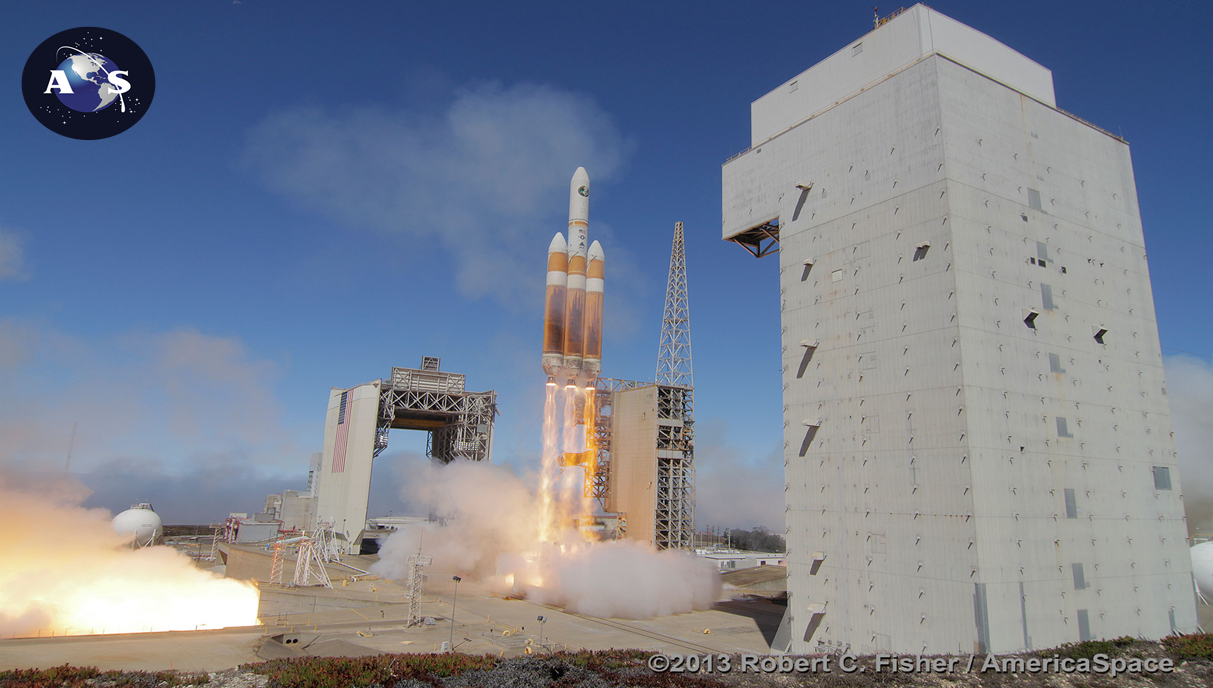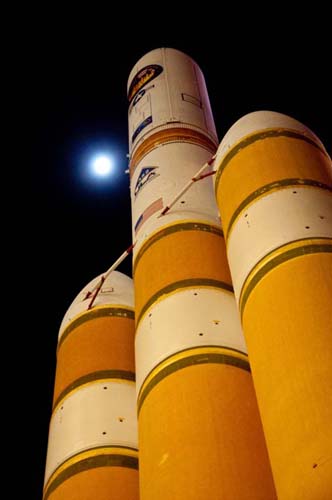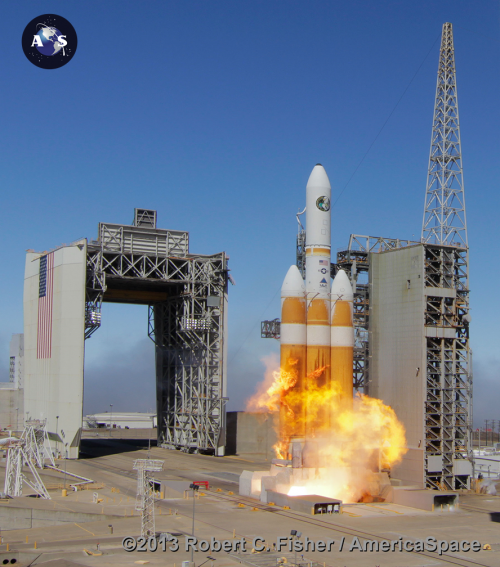
United Launch Alliance (ULA) has successfully inserted a classified payload into orbit for the National Reconnaissance Office (NRO), following today’s successful flight of a mammoth Delta IV Heavy rocket from Space Launch Complex (SLC)-6 at Vandenberg Air Force Base, Calif. The 229-foot-tall vehicle endured a 10-minute delay, apparently caused by an issue with the liquid oxygen dome purge regulators, but lifted off successfully at 11:03:22 a.m. PDT (2:03:22 p.m. EDT) Wednesday. The mission proceeded without incident, but the top-secret nature of the flight meant that ULA’s live webcast abruptly halted prior to the separation of the NROL-65 primary payload.
“We are truly honored to deliver this critical asset to orbit,” said Jim Sponnick, ULA vice president, Atlas and Delta Programs, in a statement shortly after the successful launch. “The ULA Delta IV Heavy is currently the world’s largest rocket, providing the nation with reliable, proven, heavy lift capability for our country’s national security payloads from both the east and west coasts. I congratulate the combined NRO, Air Force, ULA, and supplier team on today’s successful launch of the NROL-65 mission.”
Preparations for this mission have been ongoing for several months. The first and second stages for the Delta IV Heavy were fabricated by ULA at Boeing’s 1.5-million-square-foot Decatur, Ala., facility, after which they were transferred to Vandenberg Air Force Base aboard the M/C Delta Mariner cargo vessel. Upon arrival at the launch site, the stages underwent final assembly inside the seven-story Horizontal Integration Facility (HIF), and rollout of the Delta IV Heavy to SLC-6 took place in late April 2013, atop a diesel-powered Elevating Platform Transporter. Once the stack was “hard down” on the SLC-6 surface, a Fixed Pad Erector raised it to a vertical orientation within the 260-foot-tall Mobile Service Tower (MST).

Elsewhere, an environmentally-controlled Payload Attach Fitting (PAF) was installed on the Delta build-up stand and readied for the arrival of the NROL-65 payload. As described by ULA in its Payload Planners Guide, the installation of the spacecraft was followed by the closure of the payload fairing and transportation of the entire combination to SLC-6. During the 5 mph transfer process, dynamic loads on NROL-65 were constantly monitored. Upon arrival at the pad, environmental controls were disconnected and the PAF was lifted into the MST and mated to the Delta. Environmental control of the payload was then re-established with highly pure “Class 5000” air.
The Delta IV Heavy consists of three 134-foot-tall Common Booster Cores (CBCs), one serving as the first stage “core” and two as strap-on rockets. Topping off the stack is the 16-foot-wide (5-meter) Delta Cryogenic Second Stage (DCSS) and payload fairing, and the entire vehicle weighs an estimated 1.6 million pounds. Each CBC carries approximately 440,000 pounds of liquid hydrogen and oxygen, and each utilizes a single RS-68 cryogenic engine, developed by Pratt & Whitney Rocketdyne. When this engine was introduced in 2002, it became the first large liquid-fueled powerplant to be developed in the United States since the Space Shuttle Main Engine.
Loading of propellants into the CBCs for today’s launch of NROL-65 required a complex procedure, terminating a little over two hours ahead of launch. Ignition of all three RS-68s occurred at 11:03:09 a.m. PDT (2:03:09 p.m EDT), at T-5 seconds, enabling each engine to ramp up to its maximum 705,900 pounds of thrust. After telemetry data confirmed that the start-up sequence was satisfactory, the liftoff command was issued and the Delta IV Heavy departed the SLC-6 pad at T-0. As noted in AmericaSpace’s Launch Tracker, the hold-down bolts were detonated at 11:03:15 a.m. PDT (11:03:15 p.m. EDT) and the monster rocket left Earth seven seconds later.
According to NASASpaceflight.com, the starboard CBC engine was ignited two seconds earlier than previous missions—at T-7 seconds, rather than T-5 seconds—in an effort to reduce the “fireball” effect seen on earlier launches as the Delta’s exhaust ignited vented hydrogen gas. This had previously caused enormous scorching and even enflamed the insulation on the first stage.
As planned, soon after clearing the SLC-6 tower, with all engines burning at 102 percent of rated performance, the vehicle executed a computer-commanded pitch, yaw, and roll program maneuver. Pitch and yaw controllability was effected by gimbaling the engines themselves, whilst roll controllability was accomplished by vectoring the turbine exhaust gases of the RS-68s. This served to actively guide the Delta IV Heavy onto its proper heading and flight azimuth to deliver NROL-65 into orbit. Fifty seconds into the ascent, the core CBC throttled back to about 57 percent of rated performance to save propellant. The vehicle passed through the region of maximum aerodynamic turbulence—known as “Max Q”—at T+81 seconds and hit Mach 1.5 (1,100 mph) at 11:05:04 a.m. PDT (2:05:04 p.m. EDT). By this time, the rocket was already eight miles high.
At T+235 seconds, the thrust of the two strap-on CBCs was reduced to 57 percent, and they shut down and separated shortly afterwards. By running at 57 percent for the early phase of ascent, the core CBC thus had enough remaining propellant to support its climb after the strap-on boosters had been jettisoned. At T+246 seconds, its RS-68 throttled back up to 100 percent performance and burned for another 80 seconds. It shut down at T+328 seconds—heralding Main Engine Cutoff (MECO) at 11:09:29 a.m. PDT (2:09:29 p.m. EDT)—and separated a few seconds later.
The turn then came for the DCSS second stage and its single, hydrogen/oxygen-fueled RL-10B2 engine, capable of 24,750 pounds of thrust. This ignited at T+347 seconds. The engine features an electrically-driven extendable carbon-carbon nozzle to enhance its specific impulse and has the capacity to conduct multiple “burns” of up to 18 minutes and 45 seconds to inject its payload into orbit. The DCSS also houses the Delta’s avionics, navigation, telemetry, and communications systems and can remain “active” for more than seven hours during extended-duration mission profiles. It can also execute Contamination and Collision Avoidance Maneuvers after the separation of its primary payload.

As a launch vehicle, the Delta IV Heavy can place up to 50,000 pounds of payload into low-Earth orbit, 29,000 pounds into geostationary transfer orbit, and almost 14,000 pounds directly into geostationary orbit, more than 22,300 miles above Earth.
Unsurprisingly, both ULA and the Pentagon are remaining tight-lipped about the precise nature of NROL-65, although suspicion has been voiced that the payload may be a top-secret optical imaging satellite of the KH-11 “Kennan” class. First launched in December 1976, these satellites have passed through an estimated four generations and are thought to have been responsible for producing many detailed images of the landmasses of the former Soviet Union, China, Afghanistan, and Sudan. Two years ago, the NRO offered two obsolescent Optical Telescope Assemblies (OTAs) to NASA, and in June 2012 the space agency accepted the donation. Developed in the late 1990s and early 2000s, it was suggested that both assemblies may represent KH-11 imaging hardware and possess far higher resolutions than the Hubble Space Telescope.
Whatever the nature of NROL-65, its allocation to the 229-foot-tall Delta IV Heavy is suggestive of a large and massive payload, possibly bound for a near-polar orbital inclination. The NROL-49 spacecraft—also codenamed “USA-224”—was reportedly inserted into an orbit of 160 x 600 miles, inclined 97.93 degrees to the equator.
United Launch Alliance has overseen six Delta IV Heavy launches since the variant’s maiden voyage from Cape Canaveral Air Force Station’s Space Launch Complex (SLC)-37B on 21 December 2004. On its first flight, the rocket suffered a premature shutdown of its CBCs, which placed its DemoSat payload in an incorrect orbit and left the Three-Corner Satellites (3CS)—a trio of student-built “microsats”—at an altitude of only 65 miles, which led to their rapid decay. The cause of the failure was traced to a faulty sensor signal in the rocket’s first stage, caused by “bubbles” forming in the liquid oxygen feedlines. A second Delta IV Heavy flew from the Cape in November 2007, successfully delivering the Defense Support Program (DSP)-23 satellite into geostationary orbit.
Subsequent assignments for the mammoth rocket from the Cape included the NROL-26 reconnaissance satellite in January 2009, the NROL-32 electronic intelligence satellite in November 2010, and, most recently, the NROL-15 mission in June 2012. Together with January 2011’s NROL-49 launch from Vandenberg, this leaves the Delta IV Heavy with a current tally of six flights. Today’s NROL-65 mission was the seventh, after which another Heavy is slated to carry NASA’s first Orion spacecraft into orbit on the Exploration Flight Test (EFT)-1 from the Cape in September 2014.
Want to keep up-to-date with all things space? Be sure to “Like” AmericaSpace on Facebook and follow us on Twitter: @AmericaSpace
Missions » NROL » Missions » NROL » NROL-65 »


